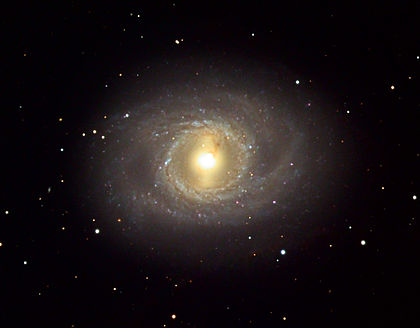- Messier 95
-
Messier 95 
M95. Credit: NASAObservation data (J2000 epoch) Constellation Leo Right ascension 10h 43m 57.7s[1] Declination +11° 42′ 14″[1] Redshift 778 ± 4 km/s[1] Distance 32.6 ± 1.4 Mly (10.0 ± 0.4 Mpc)[2] Type SB(r)b[1] Apparent dimensions (V) 3′.1 × 2′.9[1] Apparent magnitude (V) 11.4[1] Other designations NGC 3351,[1] UGC 5850,[1] PGC 32007[1] See also: Galaxy, List of galaxies Messier 95 (also known as M95 or NGC 3351) is a barred spiral galaxy about 38 million light-years away in the constellation Leo. It was discovered by Pierre Méchain in 1781, and catalogued by Charles Messier four days later.
Contents
Nucleus
The center of the galaxy contains a ring-shaped circumnuclear star-forming region with a diameter of approximately 2000 ly (600 pc).[3]
Galaxy group information
M95 is one of several galaxies within the M96 Group, a group of galaxies in the constellation Leo. The group also includes the Messier objects M96 and M105.[4][5][6][7]
References
- ^ a b c d e f g h i "NASA/IPAC Extragalactic Database". Results for NGC 3351. http://nedwww.ipac.caltech.edu/. Retrieved 2007-10-03.
- ^ Jensen, Joseph B.; Tonry, John L.; Barris, Brian J.; Thompson, Rodger I.; Liu, Michael C.; Rieke, Marcia J.; Ajhar, Edward A.; Blakeslee, John P. (2003). "Measuring Distances and Probing the Unresolved Stellar Populations of Galaxies Using Infrared Surface Brightness Fluctuations". Astrophysical Journal 583 (2): 712–726. arXiv:astro-ph/0210129. Bibcode 2003ApJ...583..712J. doi:10.1086/345430.
- ^ L. Colina, M. L. Garcia Vargas, J. M. Mas-Hesse, A. Alberdi, A. Krabbe (1997). "Nuclear Star-forming Structures and the Starburst–Active Galactic Nucleus Connection in Barred Spirals NGC 3351 and NGC 4303". Astrophysical Journal Letters 484 (1): L41–L45. Bibcode 1997ApJ...484L..41C. doi:10.1086/310766.
- ^ R. B. Tully (1988). Nearby Galaxies Catalog. Cambridge University Press. ISBN 0-521-35299-1.
- ^ P. Fouque, E. Gourgoulhon, P. Chamaraux, G. Paturel (1992). "Groups of galaxies within 80 Mpc. II - The catalogue of groups and group members". Astronomy and Astrophysics Supplement 93: 211–233. Bibcode 1992A&AS...93..211F.
- ^ A. Garcia (1993). "General study of group membership. II - Determination of nearby groups". Astronomy and Astrophysics Supplement 100: 47–90. Bibcode 1993A&AS..100...47G.
- ^ G. Giuricin, C. Marinoni, L. Ceriani, A. Pisani (2000). "Nearby Optical Galaxies: Selection of the Sample and Identification of Groups". Astrophysical Journal 543 (1): 178–194. arXiv:astro-ph/0001140. Bibcode 2000ApJ...543..178G. doi:10.1086/317070.
External links
- SEDS: Spiral Galaxy M95
- Messier 95 on WikiSky: DSS2, SDSS, GALEX, IRAS, Hydrogen α, X-Ray, Astrophoto, Sky Map, Articles and images
- Astronomy Picture of the Day: M95 on 3/14/07
Coordinates:
 10h 43m 57.7s, +11° 42′ 14″
10h 43m 57.7s, +11° 42′ 14″Messier objects List M1 · M2 · M3 · M4 · M5 · M6 · M7 · M8 · M9 · M10 · M11 · M12 · M13 · M14 · M15 · M16 · M17 · M18 · M19 · M20 · M21 · M22 · M23 · M24 · M25 · M26 · M27 · M28 · M29 · M30 · M31 · M32 · M33 · M34 · M35 · M36 · M37 · M38 · M39 · M40 · M41 · M42 · M43 · M44 · M45 · M46 · M47 · M48 · M49 · M50 · M51 · M52 · M53 · M54 · M55 · M56 · M57 · M58 · M59 · M60 · M61 · M62 · M63 · M64 · M65 · M66 · M67 · M68 · M69 · M70 · M71 · M72 · M73 · M74 · M75 · M76 · M77 · M78 · M79 · M80 · M81 · M82 · M83 · M84 · M85 · M86 · M87 · M88 · M89 · M90 · M91 · M92 · M93 · M94 · M95 · M96 · M97 · M98 · M99 · M100 · M101 · M102 · M103 · M104 · M105 · M106 · M107 · M108 · M109 · M110See also  Book:Messier objects ·
Book:Messier objects ·  Category:Messier objects
Category:Messier objects  Portal:AstronomyCategories:
Portal:AstronomyCategories:- Spiral galaxies
- Barred spiral galaxies
- M96 Group
- Leo constellation
- Messier objects
- NGC objects
- UGC objects
- PGC objects
Wikimedia Foundation. 2010.

